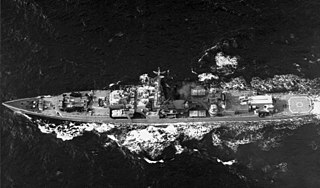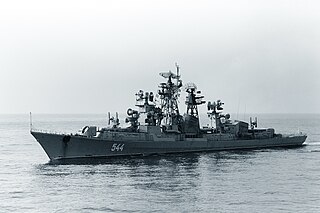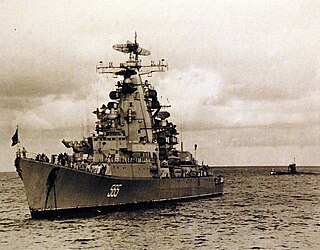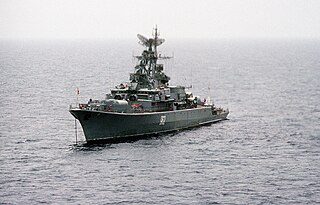
The Kresta I class, Soviet designation Project 1134 Berkut, was a class of guided missile cruiser built in the Soviet Union for the Soviet Navy. The ships were designed for a surface warfare role, but Soviet priorities were changed to an anti-submarine role and only four ships were built in this configuration. They were followed by the Kresta II class, an anti-submarine warfare variant.

The Project 58 missile cruisers, known to NATO as the Kynda class and sometimes referred to as the Grozny class, from the name of the first ship of the series to be constructed, were the first generation of Soviet missile cruisers and represented a considerable advance for the Soviet Navy. Their main role was anti-surface warfare using the SS-N-3b 'Shaddock' missile. The design proved to be top-heavy and was soon succeeded by the larger Kresta I class, but the Kyndas stayed in service until the fall of the Soviet Union.

Kronstadt was a Project 1134A Kresta II-class cruiser of the Soviet Navy, named for the Kronstadt naval base. The first ship of her class, the ship served during the Cold War, from 1969 to 1991. She served with the Northern Fleet, with her shakedown cruise being through the Mediterranean Sea. After colliding with a destroyer in 1975, she spent five years being repaired and modernized. She was decommissioned in 1991 before being sold for scrap two years later due to reduced naval funding and deteriorating conditions.

Admiral Isakov was a Kresta II-class cruiser of the Soviet Navy and briefly of the Russian Navy, named for Soviet admiral Ivan Isakov. The second ship of her class, she served mostly during the Cold War from her commissioning in 1970.
Admiral Nakhimov was a Project 1134A Kresta II-class cruiser of the Soviet Navy, named for Russian naval commander Pavel Nakhimov. The third ship of her class, the ship served during the Cold War, from 1971 to 1991. She served with the Northern Fleet for the duration of her career, often operating in the Atlantic and the Mediterranean in order to show the flag. She was decommissioned in 1991 before being sold for scrap due to reduced naval funding in 1993.

Admiral Zozulya was the lead ship of the Soviet Navy Project 1134 Admiral Zozulya-class Large Anti-submarine Ship also known as the Kresta I Class guided missile cruisers. Launched in 1965, the ship was reclassified a Large Rocket Ship in 1977. Admiral Zozulya served primarily in the Northern Fleet during the Cold War, transferring to the Russian Navy at the dissolution of the Soviet Navy, and was decommissioned in 1994 after nearly thirty years of service.

Vitse-Admiral Drozd was the third ship of the Project 1134 Berkut Large Anti-submarine Ships built for the Soviet Navy, also known as the Kresta I-class or Admiral Zozulya-class guided missile cruisers. The vessel was launched in 1966 and served with the Baltic and Northern Fleets through the 1970s and 1980s. As well as taking part in naval exercises in the Atlantic, the ship assisted in the rescue of the crew of the stricken submarine K-19 in 1972. As a consequence, the ship was named in the Northern Fleet's book of honour. The vessel was reclassified a Large Rocket Ship in 1977 to reflect its multi-purpose capability. After an upgrade in 1981, Vitse-Admiral Drozd continued to operate in the Mediterranean Sea and Atlantic Ocean. The vessel observed the 1986 United States bombing of Libya and undertook good will visits to Annaba and Dubrovnik as well as Tripoli. After being decommissioned in 1990, the ship was sent to India to be broken up in 1992 but sank en route.

Admiral Makarov was a Project 1134A Berkut A class cruiser of the Soviet Navy and briefly of the Russian Navy. The fourth ship of her class, the ship served mostly during the Cold War, from 1972 to 1992. She served with the Northern Fleet for the duration of her career, often operating in the Atlantic and the Mediterranean in order to show the flag, and was refitted between 1983 and 1985. She was decommissioned in 1992 due to deteriorating conditions which reduced naval funding prevented from being addressed before being sold for scrap in 1994.

Marshal Voroshilov was a Project 1134A Berkut A class cruiser of the Soviet Navy, which briefly became part of the Russian Navy after being renamed Khabarovsk in 1991. The fifth ship of her class, the ship served mostly during the Cold War, from 1973 to 1992.

Admiral Oktyabrsky was a Project 1134A Berkut A -class cruiser of the Soviet Navy, which briefly became part of the Russian Navy. The sixth ship of her class, the ship served mostly during the Cold War, from 1973 to 1993.

Marshal Timoshenko was a Project 1134A Berkut A class cruiser of the Soviet Navy. The eighth ship of her class, the vessel served during the Cold War with the Northern Fleet, often operating in the Atlantic Ocean but also travelling to various ports in the Mediterranean and Red Seas. The cruiser was taken out of service to be modernised in 1988 but a lack of funds meant the work was not completed. Instead Marshal Timoshenko was decommissioned in 1992.

Vasily Chapayev was a Project 1134A Berkut A class cruiser of the Soviet Navy named for the naval commander Vasily Chapayev. The Project 1134A vessels were envisaged as a counter to the attack and ballistic missile submarines operated by the members of NATO. To that end, they were equipped with two KT-106 quadruple launchers for eight 85R anti-submarine missiles in the URPK-3 Metel system. The ninth ship of the class, Vasily Chapayev was launched in 1974 and served during the Cold War with the Pacific Fleet. Based at Vladivostok, the ship travelled extensively in the Indian and Pacific Oceans, visiting a large number of friendly ports in Angola, Ethiopia, India, Mozambique and Yemen. In 1978 and 1979, the vessel formed part of a Soviet flotilla, including the Project 68bis cruiser Admiral Senyavin, that supported Vietnam in the aftermath of the Sino-Vietnamese War. In 1982, Vasily Chapayev was allocated to support the BOR-4 spaceplane programme, and two years later, the vessel participated in a search for a US Navy submarine that was suspected of being near the Kamchatka Peninsula in the Russian Far East. In 1985, the ship took part in a simulated joint operations attack on the US base at Pearl Harbor that involved the coordinated use of aircraft, ships and submarines. During the following year, the vessel took part in first joint exercises that involved both the Soviet and North Korean Navies. Taken out of active service in 1992, Vasily Chapayev was decommissioned and transferred to be broken up in 1993.

Sposobny was a Project 61 destroyer of the Soviet Navy, which briefly became part of the Russian Navy. The ship served during the Cold War from 1971 to 1989.

Admiral Isachenkov was a Project 1134A Berkut A large anti-submarine ship of the Soviet Navy. The seventh ship of the class, the vessel was launched in 1972 and served during the Cold War with the Northern Fleet, often operating in the Atlantic Ocean but also travelling to various ports in the Mediterranean Sea. The ship acted as flagship for the Minister of Defence, Marshal of the Soviet Union Andrei Grechko, during the exercise Okean-75 in 1975 and operated alongside the newly launched Project 1143 Krechyet aircraft carrier Kiev in 1977 and 1978. The ship also shadowed the NATO aircraft carriers HMS Ark Royal, USS Independence and USS John F. Kennedy. The cruiser was taken out of service for repairs in 1981 and substantially upgraded with new weapons and communications systems, re-entering service in 1982. With the end of the Cold War, the Navy reassessed its need for large warships and, after a career stretching nearly twenty years, Admiral Isachenkov was decommissioned in 1992 and sold to be broken up.

Admiral Spiridonov was a Project 1155 Fregat Large Anti-Submarine Ship, known in the west as an Udaloy-class destroyer. The ship was named after Emil Spiridonov, a Soviet admiral who died in 1981. Launched in 1984, Admiral Spiridonov served in the Pacific Fleet with the Soviet and Russian Navies successively until being decommissioned in 2001. While in service, the vessel operated in exercises in the Sea of Japan and made good will visits to a number of Soviet allies during the latter part of the Cold War in Africa and Asia.

Vladivostok was the second Soviet Navy Project 1134 Admiral Zozulya-class Large Anti-submarine Ship also known as a Kresta I guided missile cruiser. Launched on 1 August 1966, the ship was reclassified a Large Rocket Ship on 3 August 1978 to reflect the wide-ranging capability of the vessel. Serving primarily in the Pacific Fleet during the Cold War, Vladivostok took part in exercises and tours that demonstrated Soviet naval power in the Indian and Pacific Oceans. The ship played a part at a number of points of potential escalation in the Cold War, including the Indo-Pakistani War of December 1971 and the collision between the aircraft carrier Kitty Hawk and the submarine K-314 in March 1984. Vladivostok was taken out of service to be modernised and updated on 28 September 1988 but there were insufficient funds to complete the work. Instead the ship was decommissioned on 19 April 1990 and, the following January, sold to an Australian company to be broken up.

Razyashchiy was a Project 1135 Burevestnik-class Large Anti-Submarine Ship or Krivak-class frigate of the Soviet Navy. Displacing 3,200 tonnes full load, the vessel was built around the Metel anti-submarine missile system. Launched on 22 July 1974, Razyashchiy joined the Pacific Fleet of the Soviet Navy. While serving in the Arabian Sea, in 1983, Razyashchiy suffered minor hull damage from colliding with the destroyer USS Fife while approaching a US fleet. The ship also undertook visits to Port Louis, Mauritius, and Danang, Vietnam, to, among other objectives, enhance the relationships between these countries and the Soviet Union. In 1991, the vessel was transferred to the newly-formed Russian Navy. After nearly twenty years of service, however, Razyashchiy was in a poor state and so was decommissioned on 29 October 1992 and sold to be broken up on 6 October 1994.

Gordelivy was a Project 1135M Burevestnik-class Guard Ship or 'Krivak II'-class frigate that served with the Soviet and Russian Navies. Launched on 3 May 1978, the vessel operated as part of the Pacific Fleet as an anti-submarine vessel, with an armament built around the Metel Anti-Ship Complex. Gordelivy operated in the Indian and Pacific Oceans. The ship was involved in the recovery of a BOR-4 prototype spaceplane in 1982 and undertook a friendly visit to Mumbia, India, in 1985. Decommissioned and sold to a South Korean company in 1994, Gordelivy left Russia on 27 June 1995 to be broken up.

Gromkiy was a Project 1135M Burevestnik-class Guard Ship or 'Krivak II'-class frigate that served with the Soviet and Russian Navies. Launched on 11 April 1978, the vessel operated as part of the Northern Fleet as an anti-submarine vessel, with an armament built around the URPK-5 Rastrub missile system. In 1991, the ship took part in the semicentennial commemoration of the first of the arctic convoys of the Second World War alongside the Royal Navy frigate HMS London. Soon afterwards, the ship was transferred to the Russian Navy following the dissolution of the Soviet Union. Gromkiy served for less than two years in this new role before being withdrawn for repairs and, ultimately, decommissioning on 16 March 1998.

Bessmennyy was a Project 1135M Burevestnik-class Guard Ship or 'Krivak II'-class frigate that served with the Soviet and Russian Navies. The vessel was the seventh of the class to enter service. Launched on 17 September 1977, Bessmennyy was designed to operate as an anti-submarine vessel with the Northern Fleet, using an armament built around the Metel Anti-Ship Complex. Following the dissolution of the Soviet Union, in 1991, the ship was transferred to the Russian Navy and took part in a pioneering visit to Gibraltar two years later, the first time that Russian warships had visited the territory in living memory. Bessmennyy was retired on 16 March 1998, disarmed and subsequently broken up.



















